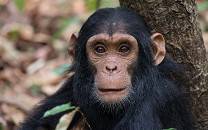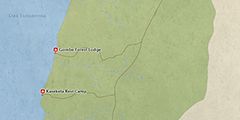Set on the shore of scenic Lake Tanganyika, forested Gombe National Park is one of the best places in Africa to track chimpanzees. Originally habituated by Jane Goodall in the 1960s, the chimps of Gombe now form the subject of the world’s longest-running study of a wild animal population. Observing these fascinating apes, which are our closest living genetic cousins, in the wild is a truly unforgettable experience.

-
Best Time To Go
- July to October (Best time to find chimps)
-
High Season
- July to October (Gombe never gets crowded)
-
Size
- 52km² / 20mi²
-
Altitude
-
767-1,606m /2,516-5,269ft
 View Photos
View Photos
 View Photos
+24
Photos
View Photos
+24
Photos
 Open Map
Open Map
Pros & Cons
- A chance to come face-to-face with chimps
- Pristine forest rising from the shore of the world’s longest and second-deepest lake
- Watching wildlife on a hike is a nice change from vehicle safaris
- Very exclusive and not crowded
- Remote from Tanzania’s other parks and relatively difficult to get to
- Accommodation options are limited
Wildlife
Gombe’s chimps are the main attraction, but the park is also home to a habituated troop of olive baboon that can usually be found on the lakeshore. Several other monkey species are present, notably the endangered Ugandan red colobus, which is sometimes hunted by chimps.
More about Gombe's wildlifeScenery
Gombe lies on the shore of Lake Tanganyika, which is the world’s second-largest freshwater lake by volume and the longest on the planet at 675km/420mi. Within the park, 13 streams run down from the forested to the sandy beach. Swim out into the lake to look back at how the forested slopes climb the steep escarpment.
Activities
The main reason most people visit Gombe is to track chimpanzees in their natural habitat, and this is far and away the most popular activity in the park. Chimp tracking aside, guided walks along the forest paths offer an opportunity to see other primates and birds, and to enjoy the lovely tropical scenery.
Weather & Climate
Gombe has a pleasant, relatively cloudless Dry season (May to October) and a humid, stormy Wet season (November to April). Due to the proximity to the equator, temperatures are quite uniform throughout the year (around 26°C/79°F during the day and 18°C/64°F at night). A lot of water can get dumped on the park when the rains come, but these usually arrive late in the day and don't last long.
More about the weather and climateBest Time To Visit
The chimps tend to stick to the lower slopes of the from July to October (the middle and end of the Dry season), so this is the best time to track them. Hiking through the forest is also much easier when the tracks are firm and dry. By contrast, in the Wet season (November to April) the forest paths tend to be slippery underfoot, and it usually requires a lot more effort to find chimps.
More about the best time to visit



